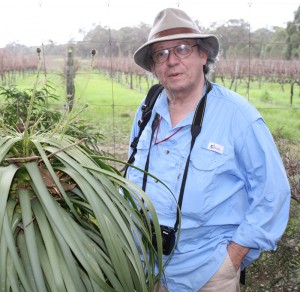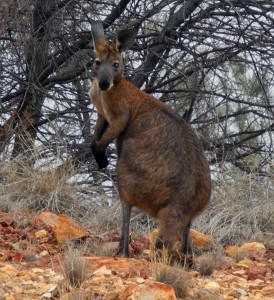Ending a Research Drought in the Australian Outback
Posted in Travelogue on April 3, 2014 by Dennis Stevenson
Dennis Wm. Stevenson, Ph.D., is Vice President for Laboratory Research at The New York Botanical Garden. One of his major research interests is plant evolution.

I spent the month of November 2013 in Australia on fieldwork for a project on the coevolution of certain plant groups and the specialized wasps that pollinate them. The plan was to collect the plants with their pollinators in the act, and to that end, I was accompanied by an entomologist, Dr. James Carpenter of the American Museum of Natural History. We also had collaborators from various herbaria and natural history museums across the continent.
The itinerary was a drive of more than 3,000 miles from Adelaide in South Australia to Brisbane in Queensland, following the River Murray in South Australia and then another river, the Darling, to Broken Hill, a mining city in New South Wales. From there, our route took us to Bourke, then Cunnamulla, and east to Brisbane. At both the start and end of the itinerary there was rain, so late spring flowers were in full bloom. But in between, things did not go quite according to plan because the Outback was in deep drought. In Cunnamulla, a police officer told us it had been more than a year since the last rainfall!

The ground cover in most places was generally non-existent, and the emus and kangaroos were coming into the towns to browse in parks, yards, and anywhere else with vegetation. In a normal year, the Fan Flower Family, Goodeniaceae, would dominate the ground cover along roadsides as well as in forests, with the wasp genus Metaparagia as the principal pollinators. Suffice it to say we found exactly one plant with one flower. In fieldwork, as in other endeavors, the best-laid plans of mice and men go oft astray.
We had traveled many thousands of miles to do fieldwork, and we were not to be denied by a mere drought.

Fortunately, gum trees (Eucalyptus), mesquite (Acacia), beefwood (Grevillea), needlewood (Hakea), and some other shrubs are pretty tough, woody desert plants. Many of these were in full bloom. Shifting the focus to studying these plants saved the expedition and, in fact, the collecting was quite successful. However, I refrained from collecting wasps; that’s what the entomologist was for. As a result of our work, we discovered wasp pollination in several genera and species of Australian shrubs and trees that were not known to have wasp associations. Moreover, we also discovered new species of wasps.
In the end, resourcefulness paid off. We will just have to make a second trip to complete the original project—if it ever rains.
Photo of Dr. Dennis Stevenson by Paula Rudall, Royal Botanic Garden, Kew.

